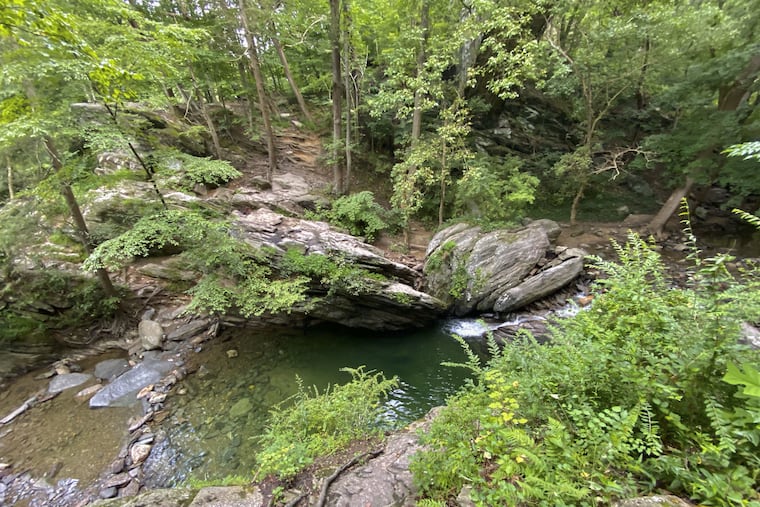No, Philadelphia should not fill Devil’s Pool with rocks | Opinion
Complaints about one of the city's most outstanding natural resources can’t be resolved simply by dumping a bunch of rocks.

Every summer in the social media era, Devil’s Pool enters another news cycle. Stories about the popular Wissahickon swimming hole tell horrific tales of parties and trash and danger. The same accounts always show people having a great time: sunbathing, picnicking, jumping into the water, doing backflips.
The annual debate over Devil’s Pool is as predictable as any other ongoing Philly argument, from the Mummers to the Phillies starting lineup. One difference this year? According to a headline from WHYY, City Councilmember Curtis Jones announced that he was supportive of filling in Devil’s Pool with rocks to deter visitors.
That must never happen.
Devil’s Pool is the dramatic culmination of Cresheim Creek’s three-mile journey from Wyndmoor to the Wissahickon. Its route forges a natural boundary between Chestnut Hill and Mount Airy and exposes the bedrock underlying the Philadelphia region. That bedrock, Wissahickon schist, is a metamorphic, semisoft rock defined by its glittering flecks of mica. It’s the same rock adorning the façades of buildings and bridges throughout the region.
At Devil’s Pool, Wissahickon schist and water team to create Philadelphia’s finest geologic display. The creek’s spillway tumbles through the schist, as it has for millions of years, carving out a natural basin some 15 feet deep, just above Cresheim Creek’s confluence with the Wissahickon Creek.
» READ MORE: Wissahickon park neighbors plan rally to draw help handling large crowds, trash, noise
All of this informed the U.S. Department of the Interior’s decision to include the Wissahickon Valley in its inaugural class of National Natural Landmarks in 1964. The NNL designation “recognizes and encourages the conservation of sites that contain outstanding biological and geological resources.”
Filling in this outstanding geological resource as a reaction to perceived overuse is a gross failure to recognize how significant Devil’s Pool is to Philadelphia’s natural history. Worse than that, filling it in would send the message that we’re more willing to spend millions to punish the actions of a few than to conserve this precious, irreplaceable public space.
Contrary to media narratives that frame Devil’s Pool as a “hidden gem,” it has been a popular gathering spot for centuries. In fact, a rustic gazebo constructed in the mid-1800s encouraged people to meet there; early era postcards at the turn of the 20th century depicted the scene from several angles. It’s always been visited and enjoyed by throngs of people, but only recently has social media made its use so conspicuous.
And with that attention comes all kinds of complaints from people who have rarely, if ever, visited Devil’s Pool. But those complaints — which include noise and graffiti and trash, all fair complaints — can’t be resolved simply by dumping a bunch of rocks. There are larger issues that need to be examined, including the fact that Parks and Recreation has had its budget slashed by 20% at a time when park use has soared.
The efforts to mitigate overuse and abuse at Devil’s Pool have been many: removing footbridges and stairs, paying for Philadelphia Police Department overtime, hiring summer seasonal help to interact with partygoers and encourage packing out their trash, posting signs prohibiting swimming. Last year, Parks and Rec removed the trash cans at Devil’s Pool, opting for the same Leave No Trace policy used at state and national parks. Each effort has met with varying degrees of success.
Now is not the time to decide to take the unprecedented measure to close Devil’s Pool by altering its natural features. We know there are things we can do, but the pandemic hampers the pursuit of meaningful alternatives: Even as the Philadelphia Water Department’s current webpage on recreation in local waterways points to community pools as safe alternatives to Devils Pool, for instance, COVID-19 has kept those pools closed.
» READ MORE: Philadelphia’s Wissahickon is slammed with millions of visitors, increasing trash, noise, risks
Filling it in with rocks is not now, and can never be, the solution. Logistics alone prevent it. Vehicular access to deposit rocks in Devil’s Pool faces the same problem with regularly removing trash there: The terrain makes it extremely difficult. Moreover, altering a protected landscape so drastically would require review and approval from several agencies, from the U.S. Department of the Interior and EPA to Parks and Rec and PWD. We would immediately regret this expensive and foolish idea to think we can correct bad behavior by correcting Mother Nature.
Yes, the trash at Devil’s Pool is bad. But not having a Devil’s Pool because of an overzealous, ham-fisted response to a problem of too many people loving a singular spot … nothing would be worse.
Bradley Maule lives in Mount Airy. In 2014, he conducted a yearlong project cleaning and documenting litter in Wissahickon Valley Park, with special focus on Devil’s Pool.